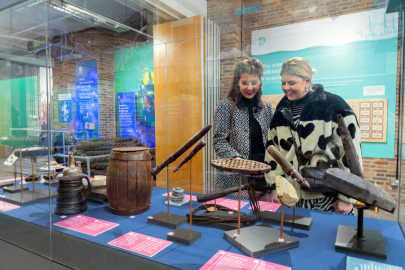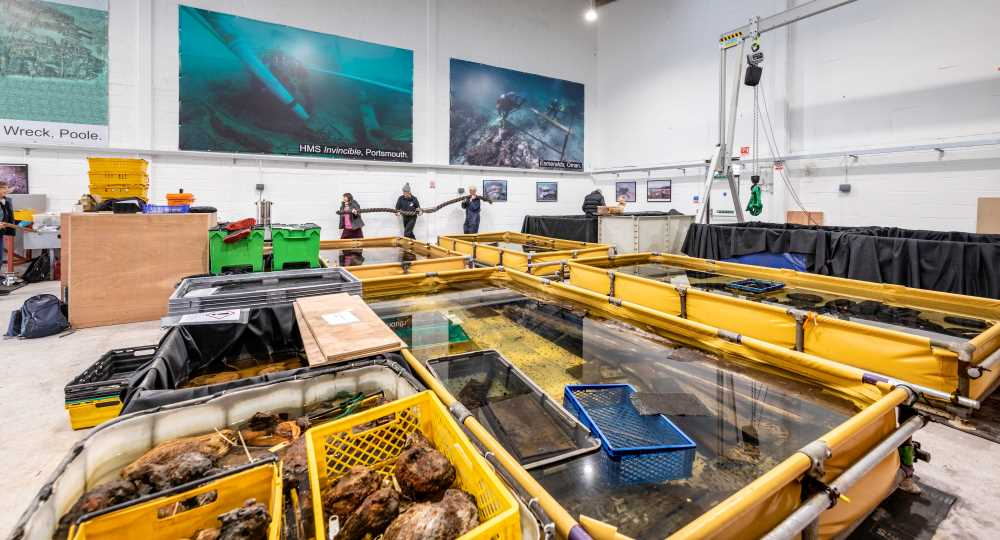Explore ground breaking underwater archaeological project in fascinating new exhibition debuting in the North of England this Spring
- View news filtered by: Media / Press Release
- View news filtered by: Hartlepool
- View news filtered by: Collections

- In a first for the North of England, Diving Deep: HMS Invincible 1744 charts a voyage to the National Museum of the Royal Navy Hartlepool to take visitors on a fascinating journey under the sea, without getting their feet wet.
- This interactive exhibition tells the story of the iconic game changing 18th century warship HMS Invincible that revolutionised ship design, and the complex three-year archaeological project to save her precious objects.
- The exhibition, which launches for Easter and features objects recovered from the ship, is supported by The National Lottery Heritage Fund. It is intended to be the legacy of the three year-long excavation which has been followed closely by the media as the most complex underwater archaeological project since the raising of the Mary Rose.
The most exciting maritime archaeological exhibition in years can be seen for the first time in the North of England when the new interactive Diving Deep: HMS Invincible 1744 exhibition opens this Easter at the National Museum of the Royal Navy Hartlepool.
Providing an insight into the extraordinary work of a team of professional and volunteer divers, the exhibition explores the fascinating discovery and underwater excavation of this 18th century battleship which sank in February 1758 when she hit a sandbank in the East Solent.
Maritime Archaeology Sea Trust Senior Archaeologist Giles Richardson with an artefact from HMS Invincible. Credit Mike Pitts.
Diving Deep: HMS Invincible 1744 has been wowing audiences in Portsmouth and Chatham Historic Dockyards since 2020, but bringing the exhibition to Hartlepool allows it to go on display alongside HMS Trincomalee, a ship built only 50 years after Invincible and comparative in size and design. Therefore, as visitors explore the extraordinary array of objects salvaged from HMS Invincible they are also able to gain a clearer insight of life on board HMS Trincomalee.
HMS Invincible was a game changing iconic ship that revolutionised ship design but ran aground on a sand bank over 260 years ago, dramatically sinking beneath the waves and was preserved for over two centuries on the ocean floor. Whilst the wreck remains on the bed of the Solent, the exhibition is the result of an emergency underwater excavation to save her precious objects that was fought against time and tides.
Visitors to the exhibition will be able to follow the story of Invincible; her capture from the French, the contribution she made to the Royal Navy and ship design and her subsequent sinking and rediscovery by a local fisherman, Arthur Mack, nearly 200 years later. It will also showcase some of the objects and findings from the Diving Deep: HMS Invincible 1744 archaeological excavation, probably the most important of its kind in UK waters for nearly 40 years.
Diving Deep will use the latest in digital technology including photogrammetry, 3D reconstruction of the excavation and new techniques in underwater filming captured on a three-screen projection, to bring the often unseen and mysterious world of underwater excavation to life in an innovative and inventive way.

Volunteers from the National Museum of the Royal Navy working on artefacts retrieved from HMS Invincible 1744. Credit NMRN
The project, which is an important collaboration with the Maritime Archaeology Sea Trust, Bournemouth University and Chatham Historic Dockyard Trust, has been made possible with funding from The National Lottery Heritage Fund, and after being on show at Portsmouth and Chatham’s Historic Dockyards.
HMS Invincible was a game changer in the way ships were built and influenced the design of one of the world’s most famous and enduring warships, HMS Victory. The 74-gun L’Invincible was originally built for the French navy in 1744 and captured by the Royal Navy in 1747. Her design was so important that by 1805, two thirds of the Royal Navy fleet were modelled on this ship, as were 16 of Nelson’s 27 ships at the Battle of Trafalgar.
She is probably the best preserved 18th century warship in the UK, and excavation over the last three years has been a race against time and tides. The ship was rediscovered in 1979 by a local fisherman Arthur Mack, and designated as a Historic Wreck in 1980. It became crucial to recover items from the ship when it was discovered that the bank the ship sits on was migrating away. Due to the work of the team, the excavation is now complete and Historic England has been able to remove the site from its Heritage at Risk Register.
Full of stores, provisions and equipment, much of the ship survived below the waves and during three years of excavation work, the team recovered significant finds such as swivel guns, a gun port lid, the main stay and even a mop head and bucket. Other finds include clay pipes, wig curlers and a number of bottles – some with their contents still preserved. Some of these items have been donated to the National Museum of the Royal Navy and will be on display in Diving Deep.
Roslyn Adamson from the National Museum of the Royal Navy Hartlepool explains:
“This is a hugely important exhibition that brings the seabed to dry land and we are delighted to welcome it to Hartlepool. We know people will love it, and it will be the perfect addition to the site following last years well received Horrible Histories: Pirate exhibition. Added to HMS Trincomalee, our reconstructed Georgian quayside, and play park really will make this a full day visit."
Clare Hunt, Principal Curator for the National Museum of the Royal Navy added:
“We’ll be exploring life above and below the water plus life on board. Visitors will get their first glimpse of newly-excavated and treated artefacts and there’s ample opportunity for hands-on, fun activities especially suitable for children.”
The exhibition opens on Saturday 1st April. Entrance is included with a valid ticket to the National Museum of the Royal Navy Hartlepool.